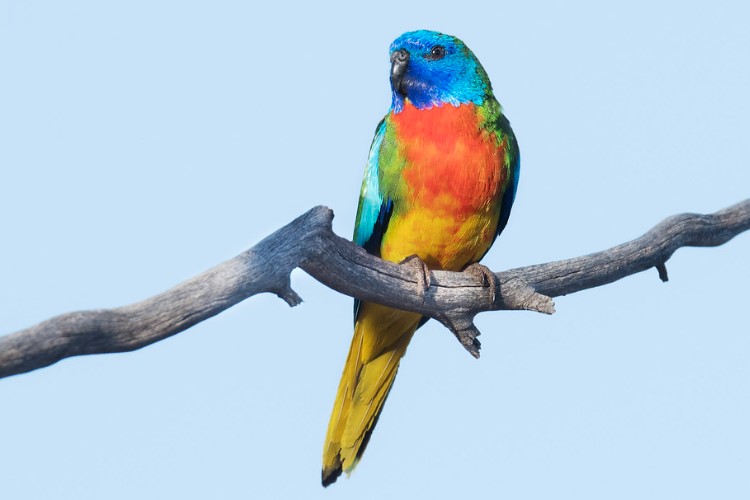Scarlet-chested Parrots (Neophema splendid) have been exhibiting spectacular irruptions and disappearances for long periods that have left ornithologists puzzled. The birds appear to follow the boom-and-bust cycle of the Australian arid zone, breeding in good seasons, crashing in bad, and wandering nomadically to find food. The movements of parrots may even follow some regular patterns, moving south in summer and north in winter in the Murray Mallee.
During the non-breeding season, the birds band in large flocks, but for nesting, they disperse in pairs or small groups. There are some hollows that are not more than four meters apart from each other. The scarlet-chested parrot is a very unobtrusive bird that spends most of its time sitting on the ground or in low shrubs, looking for seeds of grasses and herbaceous plants, in order to survive.

Their movement is extremely quiet unless flushed, which is why they may easily go unnoticed if they are not flushed. The majority of the time, they are seen in pairs or in small groups of no more than 10 people at a time.
As they have been found far from any type of water, this suggests that they obtain sufficient moisture through chewing plants that are capable of storing water, such as Calandrinia, a succulent that grows abundantly in sandy mulga country. In-flight Scarlet-chested Parrots have a striking resemblance to Turquoise Parrots when flying. The male hops enthusiastically around the female while making short, fluttering flights, as well as spreading its wings and tail during courtship. Meanwhile, he feeds her on a branch outside the nest while she is brooding.
Female Scarlet-chested Parrots have been observed carrying aromatic green leaves into their nesting cavities under their rump feathers. Using the leaves of the tea-tree Leptospernum stellatum, the female Turquoise Parrot also does this. Nest-building is not done with leaves, which are used to provide humidity or to deodorize nesting chambers. It is also known as the Scarlet-breasted Parrot and the Splendid Parrot. A Scarlet-chested Parrot measures about 200 mm in length, including its slender tail.
MALE: Upper parts are bright green. The face is brilliant blue, deepening at the throat and cheeks. The sides and flanks of breasts and necks are green. The front of the neck and the middle of the breast are scarlet. The rest of the underparts are yellow. Dusky flight feathers have dark blue underwing coverts and pale blue wing covers; the outer webs of the flight feathers are green-blue. There are blue-green tail feathers in the center and blue-green tail feathers that are broadly yellow-tipped in the outer part. The eye is dark brown in color. Cere and Bill are dark grey-black. The feet and toes are grey-brown in color.
FEMALE: A female has a paler face, and her color is restricted in the area; her breasts are entirely green. The underwings are not striped. IMMATURES: The appearance is similar to that of an adult female, but it is duller. The blue of the face is slightly darker in males. Under the wings, there is a vague cream stripe. The second annual molt takes place 15-16 months after fledging when the bird reaches its full adult plumage. DOWNY YOUNG: White-downed, yellow-billed.

Scarlet-chested Parrots have a soft twittering call, lacking the penetration of other Neophemas. Nesting and breeding typically take place between August and January, depending on rainfall and food availability. Nests are holes or hollows in trees, usually spouts in acacias or small eucalypts. The eggs are white, rounded, and about 23 x 19 mm in size; there are three to five eggs, rarely six. It was laid on wood dust. It takes a female about 18 days to incubate. It takes about four weeks for the young to fledge; after that, they remain with their parents in the family group for some months.
In southern inland Australia, this parrot is mainly found in southeastern Western Australia, central and northern South Australia, south to the middle of the Eyre Peninsula and Murray River, and east to the extreme southwestern Queensland and Darling River of New South Wales. In maLlee, acacia scrublands, clumps of trees or shrubs along stony ridges, and open saltbush or spinifex sand plains, sporadic distribution occurs. They are extremely nomadic. There are only a few records available. Read More – Mulga Parrot








